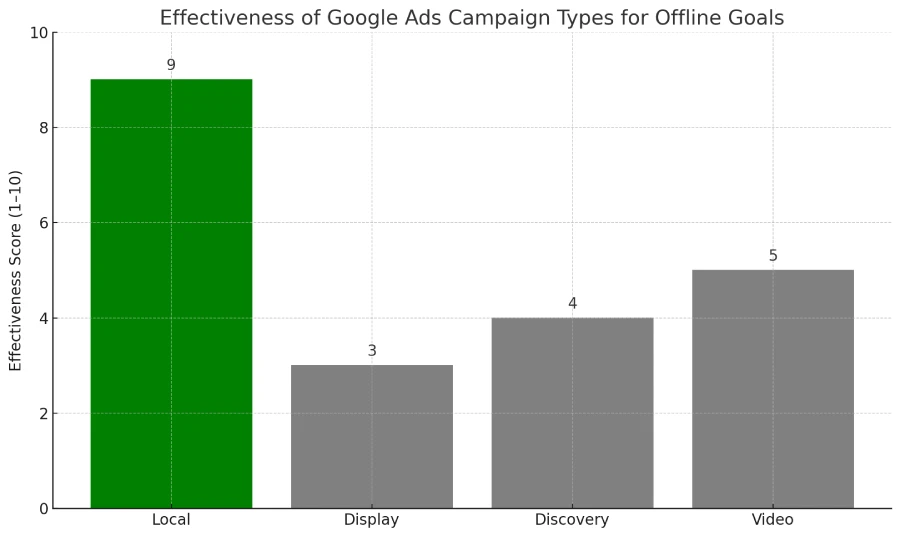The other day, I was helping a friend plan ads for his local toy store, and we hit a common roadblock: “How do we drive real foot traffic—not just website clicks?” That’s when we dived into Google Ads’ campaign types and found something perfect: Local Campaigns. If you’re a brick-and-mortar business like Jacob’s toy shop and rely on in-store visits and offline sales, this one’s for you.
In this post, I’ll break down which Google Ads campaign type is best for offline goals, explain why, debunk the wrong options, and even share a real-life example to make things crystal clear. Let’s get started!
Question
Jacob’s physical toy store relies on offline metrics such as store visits and in-store sales. He has heard that there are specialized campaign types that can help him meet these kinds of goals. Which campaign type is designed to help Jacob achieve his offline business objectives?
- Local
- Display
- Discovery
- Video
Her is a correct answer: Local ✅
If you’re interested, you can take the exam here: Google Ads Display Certification via Skillshop.
Why “Local” Is Correct:
Local campaigns are specifically designed to drive offline results like store visits, in-store purchases, and calls to physical locations. They help bridge the gap between online engagement and offline action — perfect for businesses like Jacob’s toy store.
Key Benefits:
| Benefit | Description |
|---|---|
| Store Visits | Google estimates foot traffic to your store. |
| Call-to-Actions | Prompts for directions, calls, or store hours. |
| Multi-channel Reach | Ads appear across Google Maps, YouTube, Search & Display. |
| Smart Bidding | AI-driven optimization toward offline conversions. |
📌 Example:
Jacob runs a “Buy One, Get One Free” weekend toy sale. A local campaign promotes this across Google Maps, Search, and Display, showing ads to nearby users searching for toys or kids’ activities. On Saturday, his store sees a 30% increase in foot traffic — proof of local campaign success.
Why the Other Options Are Incorrect:
| Campaign Type | ❌ Why It Doesn’t Fit Jacob’s Goal |
|---|---|
| Display | Focuses on visual ads across websites and apps — more useful for brand awareness or online engagement, not offline store visits. |
| Discovery | Reaches users across YouTube, Gmail, and Discover feed, aiming at inspiration-based browsing, but not tailored for in-store goals. |
| Video | Great for storytelling and branding, especially on YouTube, but not specialized for offline objectives like physical store visits. |

Summary Chart:
| Campaign Type | Drives Offline Goals? | Best Used For |
|---|---|---|
| Local | ✅ Yes | Store visits, calls, and in-store sales |
| Display | ❌ No | Online visibility and awareness |
| Discovery | ❌ No | Inspiring discovery-based purchases |
| Video | ❌ No | Brand storytelling, YouTube reach |
Real-Life Example
Jacob owns “ToyTreasure,” a charming toy shop in a bustling part of Austin, Texas. While his store had loyal local customers, he noticed foot traffic was slowing down — especially during weekdays. Most of his marketing was done through flyers and word-of-mouth, which limited his reach.
Jacob decided to try Google Ads’ Local Campaigns after hearing they were designed for brick-and-mortar businesses.
Here’s what happened next:
- He uploaded his store address, opening hours, and product images (like popular action figures and educational toys).
- Google automatically placed his ads across Google Maps, Search, YouTube, and even partner websites — only targeting people nearby or searching for toys in the area.
- When a parent searched for “best toys for 5-year-olds near me,” Jacob’s shop appeared with directions, reviews, and even a promo like “10% Off This Week.”
Results After One Month:
- 📍 1,200 people viewed his store listing on Google Maps.
- 👣 130 new walk-ins were tracked as store visits from Google Ads.
- 💳 In-store sales increased by 22% during the campaign.
Jacob didn’t need to learn complex ad setups — Google’s automation handled everything. By focusing on Local campaigns, he reached customers at the right place and time and boosted real-world results without relying on online orders.
Helpful Resources:
- Google Ads – About Local Campaigns
- Google Ads Certification – Skillshop
- Case Study: Local Ads Drive Store Visits
FAQs:
1. What is a Local Campaign in Google Ads?
A Local Campaign is a type of automated campaign designed to help businesses drive foot traffic to physical locations. It shows ads across Search, Maps, YouTube, and the Display Network to nearby potential customers, encouraging in-store visits.
2. How do Local Campaigns track in-store visits?
Google uses aggregated and anonymized data from users who have opted into Location History on their devices. When someone clicks your ad and later visits your store, Google may count that as a store visit.
3. Do I need a website to run a Local Campaign?
No. While having a website helps, Local Campaigns can work without one by directing users to your Google Business Profile or Maps listing.
4. How is the budget spent in a Local Campaign?
Google’s smart bidding automatically allocates the budget to maximize foot traffic and conversions. You just set a daily or monthly budget, and Google optimizes delivery across channels.
5. Can I run both Local and Online campaigns together?
Yes. Many businesses run Local Campaigns to drive in-store visits and Search/Display/Shopping campaigns to drive online sales. Each campaign targets different customer behavior.
6. What kind of businesses benefit most from Local Campaigns?
Local campaigns are ideal for:
Retail shops (toys, clothes, electronics)
Restaurants & cafes
Service providers (salons, gyms, clinics)
Any business with a physical location that relies on in-person visits
7. How long does it take to see results from a Local Campaign?
Most businesses begin to see increased foot traffic within 1–2 weeks, though it can vary based on location, budget, and ad creatives.
8. Can I use Local Campaigns during seasonal events like Black Friday or Christmas?
Absolutely! Local campaigns are highly effective during holiday seasons, store events, or clearance sales — when people are actively searching for nearby deals.
Conclusion:
If Jacob wants to boost in-store traffic, calls, and offline purchases, then Local campaigns are the smart choice. They help connect with nearby customers exactly when they’re searching, turning Google Ads into real-world footfall.
Now, if you are ready, you can take the Google Skillshop test for the Google Ads Display Exam. Want more real exam questions with easy answers like this? Follow along — I’ll be breaking down more Google Ads Display Measurement Certification Free examples in the next posts.
